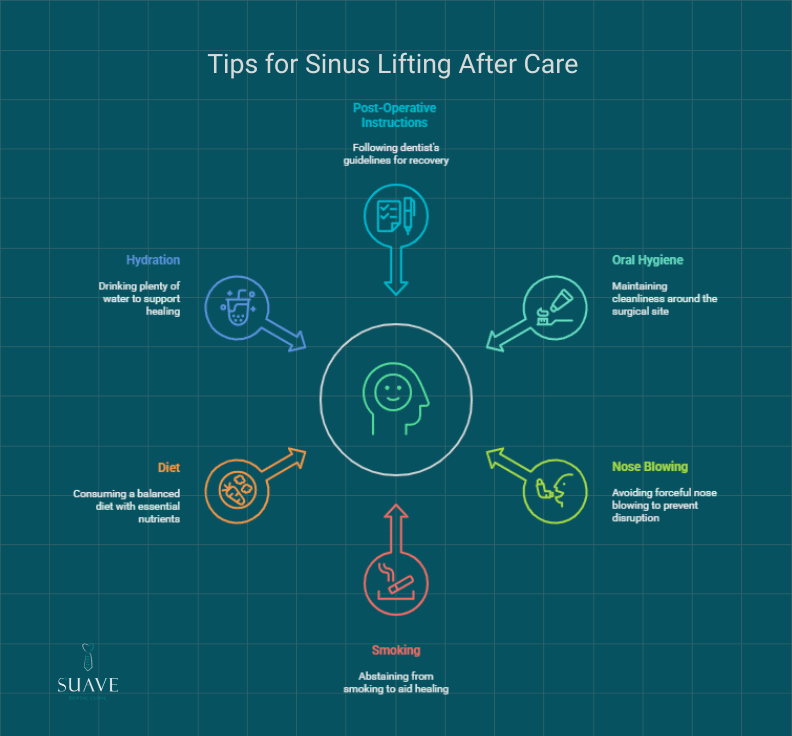
Table of Contents
Sinus Elevation surgery is one of the most common surgeries in dental implant placement procedures. Many patients who need to restore the missing upper back molars can’t receive durable implants without a sinus lift surgery in the first place.
At Suave Clinic, our expert dental surgeons pay strong attention to the healing phases and postoperative aftercare to achieve proper Sinus Lift recovery without long-term sinus lift side effects.
Following your dentist’s post-operative instructions and attending your follow-up appointments is crucial to treat any complications and side effects that may occur.
What Is The Sinus Lift Recovery Time?
Although the healing time for a sinus lift procedure varies from person to person, it generally takes about 2 to 3 weeks for initial healing. Full healing and bone maturation usually take 6 to 9 months, after which implant placement can be considered.
The recovery period is a critical phase that requires patience and careful attention to postoperative instructions. It consists of successive stages.
The first 24 to 48 Hours
- During this immediate postoperative period, it’s normal to have some bleeding. You have to bite down gently on the gauze pack that has been placed over the surgical area.
- Swelling is very common and usually peaks around 48 to 72 hours. You can apply ice packs to the outside of your face in the surgical area for 20 minutes on, then 20 minutes off.
- You may feel mild pain and discomfort after the procedure. Take the prescribed pain medications as directed. Don’t wait for the pain to become severe before taking the medication.
During the first week,
- You need to rest and keep your head elevated, even while sleeping, to minimize swelling.
- Maintaining good oral hygiene is essential. While gently brushing your teeth, avoid the surgical side, and you can use salt water to rinse gently.
- During this period, stick to soft, cool foods and avoid hot liquids. Alcohol and smoking are strictly forbidden.
- Your nose might feel stuffy, similar to having a cold. This is normal and should resolve over time.
- The surgical area and nearby teeth may be sensitive for a while.
2 Weeks After Sinus Lift,
- If your dentist used non-dissolvable stitches, you will have an appointment to remove them, usually within 7 to 10 days.
- During this period, swelling and discomfort should gradually subside.
- You can gradually return to normal activities, but continue to avoid strenuous exercise. Also, gradually return to your normal diet.
1 to 9 Months (Long-Term Recovery)
- Full recovery and healing usually take between 6 to 9 months.
- During this period, the bone graft material will gradually be replaced by your own new bone.
- It is very important to have regular check-up appointments to monitor healing.
- If you are planning to have dental implants, your dentist will determine when the bone has healed sufficiently for implant placement.
Tips for Sinus Lifting After Care
- It is very important to adhere carefully to your dentist’s post-operative instructions.
- You have to maintain good Oral Hygiene, but be gentle around the surgical site.
- Don’t blow your nose forcefully and try not to sneeze with your mouth closed for at least two weeks.
- Smoking can affect the healing process.
- To support healing, try to eat a balanced diet rich in vitamins and minerals like vitamin C and zinc.
- Drink plenty of water, but avoid using straws as the sucking motion can disrupt healing.

What Is The Success Rate Of A Sinus Lift?
The sinus lift procedure has a high success rate, usually around 90-95%. However, while the procedure is generally successful, complications can occur.
The success of the procedure depends on various factors, such as the skill and experience of the surgeon, the patient’s overall health, adherence to postoperative instructions, and the quality and quantity of existing bone.
Get A Free Dental Consultation
Get A Personalized Treatment Plan and Quotation
Sinus Lift Side Effects And Complications
The sinus lift procedure is generally safe and effective, but like any other surgical procedure, it carries some risks of side effects and complications. Some of these complications are common and considered normal reactions that usually resolve on their own, while others are long-term or potential complications that may require medical attention.
Common complications.
- Facial swelling is common and very normal after the procedure and usually peaks by itself after 48 to 72 hours following surgery. To help reduce swelling, you can use ice packs on the outer side of your face.
- Some patients may experience bruising on the face or neck, which is very normal.
- Minor bleeding after surgery during the first 24 to 48 hours is very normal. You have to follow your dentist’s instructions to reduce bleeding after the surgery.
- Mild to moderate pain and discomfort are expected, and using prescribed pain medications after surgery will help with that.
- You may feel your nose is congested for a few days to a few weeks after surgery.
Potential complications.
- Infection can occur after surgery, but it’s not very common. Signs of infection include fever, severe pain, or pus discharge.
- The sinus membrane may tear during the procedure, but in most cases, it can be repaired during the surgery.
- The bone graft may not integrate properly with your existing bone, leading to graft failure.
- If implants are placed too soon after the sinus lift, before proper healing has occurred, it may result in implant failure.
- Oroantral fistula may occur, which is an abnormal passageway between the mouth and the sinus.
What Are The Signs Of A Failed Sinus Lift?
It is very important to know the signs that might indicate a failed sinus lift:
- Severe or increasing pain after the initial recovery period could indicate a problem.
- Swelling that doesn’t subside or gets worse after the first week could be a sign of infection or other complications.
- Fever could indicate an infection.
- If you are experiencing a foul taste or odor, this could be a sign of infection or graft failure.
- While mild bleeding is normal initially, persistent bleeding is not.
- If you had clear or colored discharge from your nose, it could indicate a sinus membrane perforation.
- Difficulty breathing through the nose could suggest complications.
- If you feel or see small granules in your mouth, it could mean the graft material is coming out.
- After placement of the implants, any looseness could indicate failure of the sinus lift or implant integration.
If you experience any of these signs, you must contact your oral surgeon immediately, as early intervention can prevent more serious complications and improve outcomes. Or send us a message now for a quick, free online consultation with our dentist.
References
Medically Reviewe